According to Polynesian myth Aldebaran
and Sirius once upon a time joined forces to overturn a
great Tara.
"... Cox, however, goes back of this
classic title [for Ursa Major] and says:
They who spoke of the seven triones
had long forgotten that their fathers spoke of the
taras (staras) or strewers of light,
and Al Bīrūnī
derived the word from taraņa, 'passage', as of
the stars through the heavens. Thus from the results of
modern philological research it is possible that our
long received opinions as to the derivations of many
star-names should be abandoned, and that we should
search for them far back of Greek and Rome." (Allen)
This involved the place (-ga) of
the Pleiades:
... the Little Eyes are Matariki,
and at one time but a single star, so bright that their
god Tane in envy got hold of Aumea, our
Aldebaran, and, accompanied by Mere, our Sirius,
chased the offender, who took refuge in a stream.
Mere, however, drained off the
water, and Tane hurled Aumea at the
fugitive, breaking him into the six pieces that we now
see, whence the native name for the fragments, Tauono,
the Six ...
But it seems Tane (the 'Tree') did not quite succeed
in his efforts because these 6 fragments continued to
have a great influence
on the people, who in their inner minds still clearly
could see
this place in front of them.

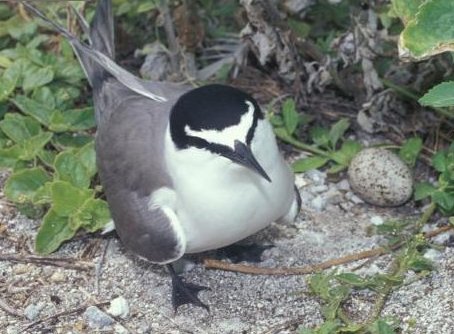
... Skulls
with incised carvings, imbued with power by Makemake,
were placed in the fowl house to promote the egg-laying
capacity of the occupants. It may seem a long call from
the domestic fowl to the sooty tern, but both are birds
and lay eggs. The sooty tern (manu tara) comes to
breed in large numbers in July or August off the
southwestern point formed by the crater of Rano-kao
on three rocky islets, of which the only one accessible
to swimmers is Motu-nui.
What
commenced as an ordinary food quest for eggs became an
annual competition to obtain the first egg of the
season. The warriors (matatoa) of the dominant
tribe entered servants for the annual Derby, and members
of defeated tribes were not allowed to take part in the
competition. The selected servants swam over to
Motu-nui and waited in caves for the migration of
the birds. The warriors and their families assembled on
the lip of Rano-kao that overlooked the course.
Owing to the strong wind, they built houses of stone for
shelter at the village named Orongo, the
Place-of-listening. There they listened for the coming
of the birds and waited for the call of the successful
servant who found the first egg. While waiting they
amused themselves with singing and feasting and carved
on the adjacent rock figures with birds' heads and human
bodies, the symbol of Makemake, god of fowls and
sea-birds.
In time,
rules and ritual were developed about this annual
competition which became the most important social event
on the island. The successful servant leaped onto a
rocky promontory and shouted across the water to his
master 'Shave your head.
The egg is yours.'
A sentry on
watch in a cave below Orongo, termed the
Bird-listener (Hakaronga-manu), heard the call
and relayed the message up to the waiting masters. The
successful master was termed the Bird-man (Tangata
manu). On reception of the egg, the people escorted
him to Mataveri, where a feast was held in his
honour. After that he went into seclusion for a year in
a house at Rano-raraku.
The
details of his functions and privileges are not known,
but certain it is that he was held in high honour and
provided with food by the people until the next annual
Derby took place. The list of Bird-men was memorized and
transmitted like a list of kings ...
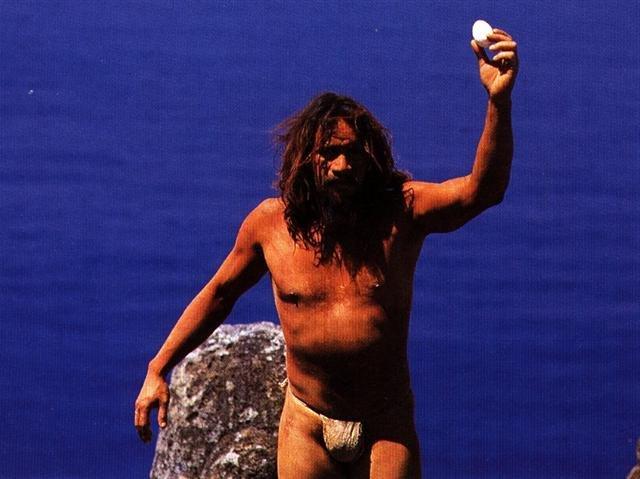
...
Manu-tera, the Easter Island name for the sooty
tern, means literally 'sunbird'. From this we take it as
very likely, though there is no proof, that the tern
would have been seen as a symbol of the sun - just as
the falcon and the phoenix were symbols of the sun in
ancient Egypt. The latter, the mythical Bennu
bird, was associated with Heliopolis ('the City
of the Sun') and with the pyramid-shaped Benben
sunstone, and was famously linked to an egg:
As its end
approached the phoenix fashioned a nest of aromatic
boughs and spices, set it on fire, and was consumed in
the flames. From the pyre miraculously sprang a new
phoenix, which, after embalming its father's ashes in an
egg of myrrh, flew with the ashes to Heliopolis
where it deposited them on the altar in the temple of
the sun god Ra.
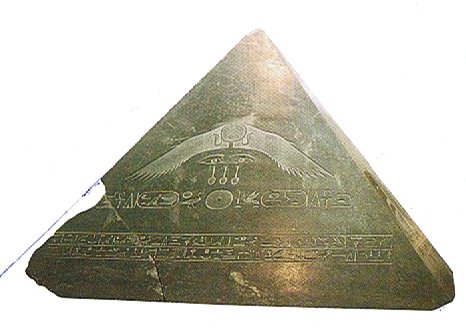
The
possibility cannot be ruled out that the birdman cult of
Easter Island may have expressed ideas such as these.
'If one were to propose antecedents to the practice',
comments the historian R. A. Jairazbhoy: the thought of
the Egg of the Egyptian sun god (the cosmic egg) would
have to come to mind. The Book of the Dead says
that this egg was laid by Kenkenur, or 'the Great
Cackler' (an alias of the phoenix), and the deceased
watches and guards it. This is declared in the Chapter
headed 'Having Dominion over the Water in the
Underworld'. And again the journey on the reed float
across the sea is reminiscent of the journey of the
Egyptian sun god Ra to the horizon on reed floats
...
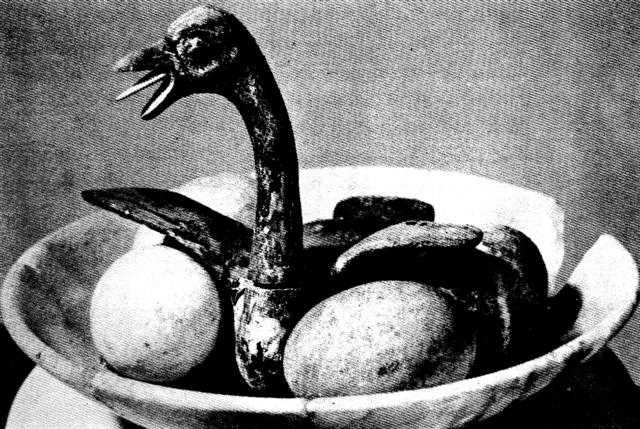
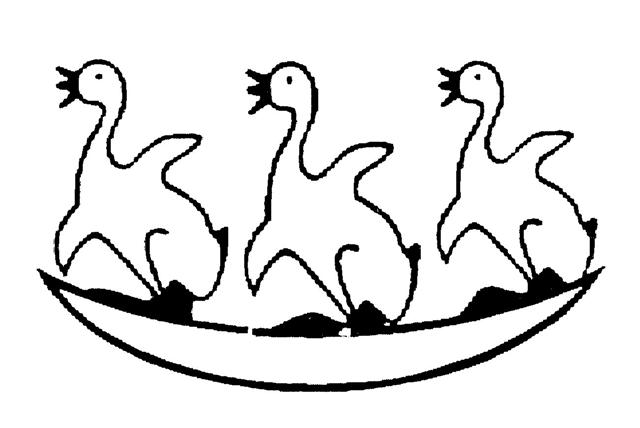
... This hieroglyph was used as a
determinative for the word sesch, 'bird's
nest', and in ideographs like tau, 'young
bird, nestling' ... The sign shows a few, usually
three, ducklings or possibly green geese ... in a
nest formed like the crescent of the moon. Sometimes
there are eggs instead of young birds in the nest
...
... They
all sat down and rested [on the plain of Oromanga],
when suddenly they saw that a turtle had reached the
shore and had crawled up on the beach. He [Ira]
looked at it and said, 'Hey, you! The turtle has come on
land!' He said, 'Let's go! Let's go back to the shore.'
They all went to pick up the turtle. Ira was the
first one to try to lift the turtle - but she didn't
move. Then Raparenga said, 'You do not have the
necessary ability. Get out of my way so that I can have
a try!' Raparenga stepped up and tried to lift
the turtle - but Raparenga could not move her.
Now you spoke, Kuukuu: 'You don't have the
necessary ability, but I shall move this turtle. Get out
of my way!' Kuukuu stepped up, picked up the
turtle, using all his strength. After he had lifted the
turtle a little bit, he pushed her up farther. No sooner
had he pushed her up and lifted her completely off the
ground when she struck Kuukuu with one fin. She
struck downward and broke Kuukuu's spine.

The turtle
got up, went back into the (sea) water, and swam away.
All the kinsmen spoke to you (i.e. Kuukuu): 'Even
you did not prevail against the turtle!' They put the
injured Kuukuu on a stretcher and carried him
inland. They prepared a soft bed for him in the cave and
let him rest there. They stayed there, rested, and
lamented the severely injured Kuukuu. Kuukuu
said, 'Promise me, my friends, that you will not abandon
me!' They all replied, 'We could never abandon
you!' They stayed there twenty-seven days in Oromanga.
Everytime
Kuukuu asked, 'Where are you, friends?' they
immediately replied in one voice, 'Here we are!' They
all sat down and thought. They had an idea and Ira
spoke, 'Hey, you! Bring the round stones (from the
shore) and pile them into six heaps of stones!' One of
the youths said to Ira, 'Why do we want heaps of
stone?' Ira replied, 'So that we can all ask the
stones to do something.' They took (the material) for
the stone heaps (pipi horeko) and piled up six
heaps of stone at the outer edge of the cave. Then they
all said to the stone heaps, 'Whenever he calls,
whenever he calls for us, let your voices rush (to him)
instead of the six (of us) (i.e., the six stone heaps
are supposed to be substitutes for the youths). They all
drew back to profit (from the deception) (? ki honui)
and listened. A short while later, Kuukuu called.
As soon as he had asked, 'Where are you?' the voices of
the stone heaps replied, 'Here we are!' All (the youths)
said, 'Hey, you! That was well done!'
...
The role of Aldebaran could evidently
have been to
serve as a marker for the place of spring equinox at a
specific point in ancient time (where he once upon a
time had brought light, as Luci-fer, or as Jus-piter,
Father of Light), whereas the role of
Sirius should have been to serve as a permanent marker
for the last day of June - always to follow the Sun instead of the
starry dome
when the precessional clock created time.
... The
Sothic cycle was based on what is referred to in
technical jargon as 'the periodic return of the heliacal
rising of Sirius', which is the first appearance of this
star after a seasonal absence, rising at dawn just ahead
of the sun in the eastern portion of the sky. In the
case of Sirius the interval between one such rising and
the next amounts to exactly 365.25 days - a
mathematically harmonious figure, uncomplicated by
further decimal points, which is just twelve minutes
longer than the duration of the solar year ...
... The month, which takes its name from Juppiter the
oak-god, begins on June 10th and ends of July 7th.
Midway comes St. John's Day, June 24th, the day on which
the oak-king was sacrificially burned alive. The Celtic
year was divided into two halves with the second half
beginning in July, apparently after a seven-day wake, or
funeral feast, in the oak-king's honour ...
Perhaps these June 10th,
June 24th, and
July 7th, referred to a year with 10 months, ending with
December. June (the month of Father Light, Jus-piter)
could then have arrived 2 months earlier than today,
i.e. with Aldebaran not in May 28 (as at the time of
rongorongo) but in MARCH 25 (84) = 148 (May 28) -
64 (= 8 * 8).
...
Strassmeier and Epping, in their Astronomishes aus
Babylon, say that there its stars formed the third
of the twenty-eight ecliptic constellations, -
Arku-sha-rishu-ku, literally the Back of the
Head of Ku, - which had been established along that
great circle milleniums before our era; and Lenormant
quotes, as an individual title from cuneiform
inscriptions, Dil-kar, the Proclaimer of Dawn,
that Jensen reads As-kar, and others Dil-gan,
the Messenger of Light.
George
Smith inferred from the tablets that it might be the
Star of the Flocks; while other Euphratean names
have been Lu-lim, or Lu-nit, the
Ram's Eye; and Si-mal or Si-mul, the Horn
star, which came down even to late astrology as the
Ram's Horn.
It
also was Anuv, and had its constellation's titles
I-ku and I-ku-u, - by abbreviation Ku,
- the Prince, or the Leading One, the Ram that led the
heavenly flock, some of Ýts titles at a different date
being applied to Capella of Auriga.
Brown associates it with Aloros, the first of the ten
mythical kings of Akkad anterior to the Deluge, the
duration of whose reigns proportionately coincided with
the distances apart of the ten chief ecliptic stars
beginning with Hamal, and he deduces from this kingly
title the Assyrian Ailuv, and hence the Hebrew
Ayil; the other stars corresponding to the other
mythical kings being Alcyone, Aldebaran, Pollux,
Regulus, Spica, Antares, Algenib, Deneb Algedi, and
Scheat
...
Furthermore,
we ought to consider the calendar of Gregory XIII as
regards these dates in 'June / July':

|
APRIL 9 (*19) |
10 (100) |
11 |
 |
 |
 |
|
Ga1-19 |
Ga1-20 |
Ga1-21 |
|
KHAFRE |
MENKAURE |
ο Aurigae (85.8), γ Leporis (85.9)
YANG MUN (α Lupi)
 |
|
Al Hak'ah-3 /
Mrigashīrsha-5 /
Turtle-20 /
Mas-tab-ba-tur-tur (Little Twins)
ARNEB = α Leporis,
Crab Nebula = M1 Tauri
(83.0,
φ╣ Orionis
(83.1),
HEKA = λ Orionis,
Orion Nebula = M42
(83.2),
φ▓ Orionis
(83.6),
ALNILAM = ε Orionis
(83.7) |
Three Stars-21
/
Shur-narkabti-sha-shūtū-6 (Star in the
Bull towards the south) /
ANA-IVA-9 (Pillar of exit)
HEAVENLY GATE = ζ Tauri,
ν Columbae (84.0), ω Orionis
(84.2),
ALNITAK = ζ Orionis,
PHAKT (Phaet) = α Columbae
(84.7) |
|
June 12 |
13 (*84) |
14 (165) |
|
░June 8 |
9 (*80) |
10 (161) |
|
'May 16 (136) |
17 |
18 (*58) |
|
"May 2 |
3 (133) |
4 (*54) |
|
NAKSHATRA DATES: |
|
OCTOBER 9 (*202) |
10 |
11 (284) |
|
December 12 |
13 |
14 (*268 = *85 + 183) |
|
░December 8 |
9 |
10 (*264 = *81 + 183) |
|
'November 15 |
16 (*240) |
17 (321) |
|
"November 1 |
2 (306) |
3 (*227) |

And at the time when the
Pope Gregory XIII launched his new calendar he had
heliacal Sirius at ║June 30, to where the
precession since the time of the Bull had pushed the stars
between Gemini and Cancer, from MAY 1 (121 = 11 * 11) to
day 181 (= 121 + 60):
|
APRIL 29 |
30 |
MAY
1 (*41) |
2
(122) |
 |
 |
 |
 |
|
Ga2-9 |
Ga2-10 |
(284 = 41 + 1 + 242) |
Ga2-12 (42) |
|
Mash-mashu-sha-Risū-9 (Twins of the Shepherd
?)
θ
Gemini (103.0), ψ8 Aurigae (103.2),
ALHENA
= γ Gemini
(103.8), ψ9 Aurigae (103.9) |
ADARA (Virgin)
= ε
Canis Majoris
(104.8) |
ω
GEMINI
(105.4),
ALZIRR = ξ Gemini
(105.7),
MULIPHEIN = γ Canis Majoris
(105.8),
MEKBUDA = ζ Gemini
(105.9) |
7h
(106.5)
no
star listed (106) |
|
July
2 |
(*104 = 8 * 13) |
4 (185) |
5 |
|
║June 28 |
29
(*100) |
SIRIUS |
║July 1 (182) |
|
'June 5 |
6
(157) |
7
(*78) |
8 |
|
"May
22 |
23 |
24
(144) |
25 (*65) |
|
NAKSHATRA DATES: |
|
OCTOBER 29 |
30
(303) |
31
(*224) |
NOVEMBER 1 |
|
χ Oct. (286.0),
AIN
AL RAMI = ν Sagittarii
(286.2), υ Draconis
(286.4), δ Lyrae (286.3),
κ
Pavonis
(286.5),
ALYA = θ Serpentis
(286.6) |
ξ Sagittarii
(287.1),
ω Pavonis
(287.3), ε Aquilae, ε Cor. Austr.,
SULAPHAT = γ Lyrae
(287.4), λ Lyrae (287.7),
ASCELLA = ζ Sagittarii, BERED = i Aquilae (Ant.)
(287.9) |
Al
Na'ām-18 /
Uttara Ashadha-21
NUNKI
= σ Sagittarii
(288.4), ζ Cor. Austr. (288.5),
MANUBRIUM = ο Sagittarii
(288.8), ζ
Aquilae (288.9) |
19h
(289.2)
λ Aquilae (Ant.)
(289.1), γ Cor. Austr (289.3),
τ Sagittarii
(289.4), ι Lyrae (289.5), δ Cor. Austr. (289.8)
|
|
January 1 |
2 |
3
(368) |
4 |
|
░December 28 |
29 |
30
(364) |
31 |
|
'December 5 |
6
(340) |
7
(*261) |
8 |
|
"November 21 |
22 |
23
(327) |
24
(*248) |
In the G text a great fish-hook was placed here
- at the
time when the Full Moon was
at Nunki and in ║December
30. Traditionally it was well known that Nunki announced
the beginning of the 'Sea' and therefore heliacal Sirius
at the opposite side of the year ought to be located
precisely
in ║June 30 in order to show where new 'Land' was
drawn up (emerging up into light as after a high tide).
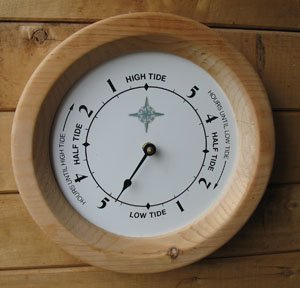
...
This [σ
Sagittarii]
has been identified with Nunki of the Euphratean
Tablet of the Thirty Stars, the Star of the
Proclamation of the Sea, this Sea being the
quarter occupied by Aquarius, Capricornus, Delphinus,
Pisces, and Pisces Australis. It is the same space in
the sky that Aratos designated as Water
...

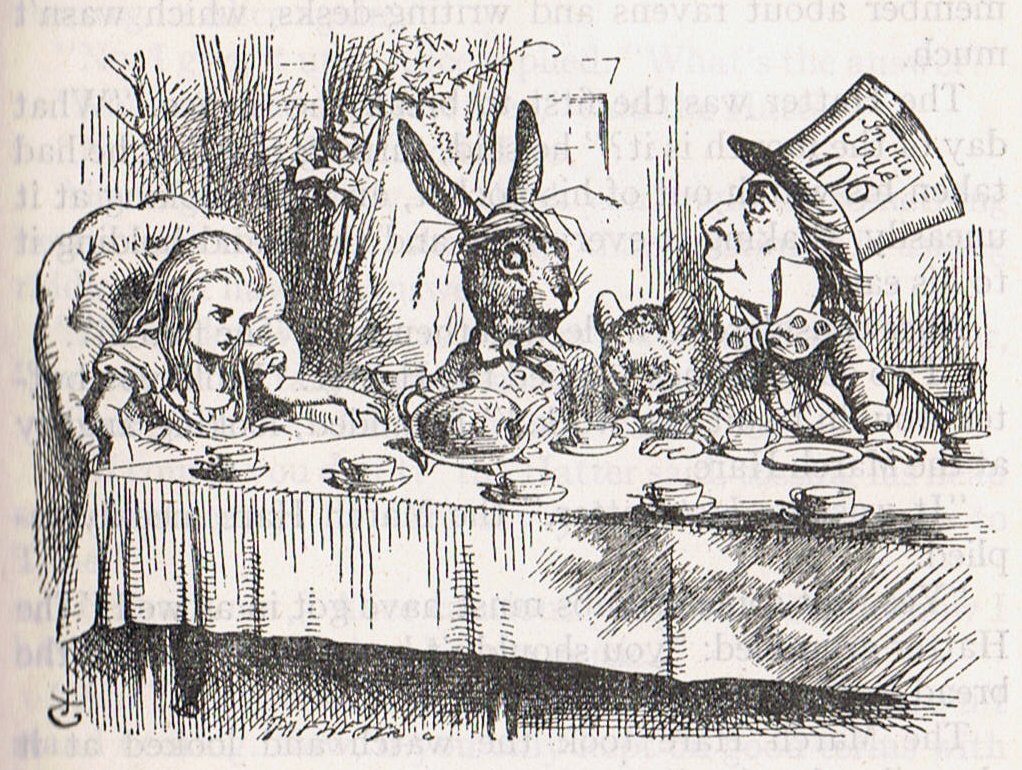
... 'I
wan't a clean cup', interrupted the Hatter: 'let's all
move one place on.' He moved as he spoke, and the
Dormouse followed him: the March Hare moved into the
Dormouse's place, and Alice rather unwillingly took the
place of the March Hare. The Hatter was the only one who
got any advantage from the change; and Alice was a good
deal worse off than before, as the March Hare had just
upsed the milk-jug into his plate ...
...
In the
morning of the world, there was nothing but water. The
Loon was calling, and the old man who at that time bore
the Raven's name, Nangkilstlas, asked her why.
'The gods are homeless', the Loon replied. 'I'll see to
it', said the old man, without moving from the fire in
his house on the floor of the sea. Then as the old man
continued to lie by his fire, the Raven flew over the
sea. The clouds broke. He flew upward, drove his beak
into the sky and scrambled over the rim to the upper
world. There he discovered a town, and in one of the
houses a woman had just given birth.
The
Raven stole the skin and form of the newborn child. Then
he began to cry for solid food, but he was offered only
mother's milk ...
This could have been the background for the
various Polynesian myths describing how once upon a time
their Lands had been drawn up from the deeps of the
sea as if their islands had been great fishes.
The idea could have been very
ancient, because the Phoenician alphabet had 2 parts -
Land and Water - and with a fish hook as the dominating idea
at the end of 'Water' (= just preceding 'Land' in cyclic
time). Nun
as in Nun-ki was the fish to be once again caught:
|
Egyptian flail |
 |
Phoenician lamed |
 |
Greek
psi |
Ψ (ψ) |
|
Wikipedia: In writing, the early letter
appears in an angular shape ( ).
There were early graphical variants that
omitted the stem, 'chickenfoot-shaped
psi', as: ).
There were early graphical variants that
omitted the stem, 'chickenfoot-shaped
psi', as:
 or
or

In later
research it was postulated that the
[Phoenician] alphabet is actually two
complete lists, the first dealing with
land agriculture and activity, and the
second dealing with water, sea and
fishing.
The first half beginning
with Alef - an ox, and ending
with Lamed - a whip. The second
list begins with Mem - water, and
continues with Nun - fish,
Samek - fish bones, Ayin - a
water spring, Peh - the mouth of
a well, Tsadi - to fish, Kof,
Resh and Shin are the hook
hole, hook head and hook teeth, known to
exist from prehistoric times, and the
Tav is the mark used to count the
fish caught.
The Crook and Flail were
instruments of the Pharaoh:
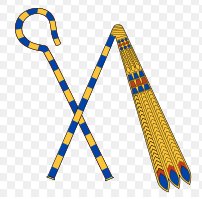 |
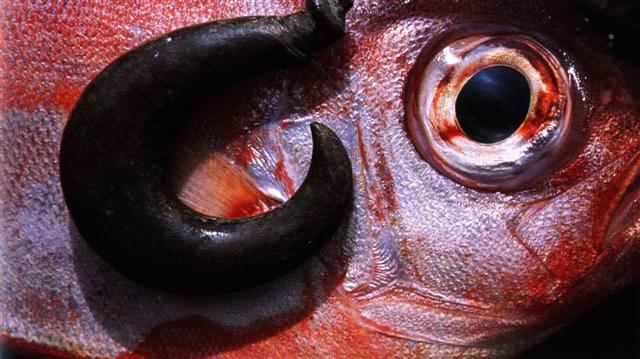
By the way, possibly we have here an
explanation of Metoro's words at Ca1-20, where his 'fishbone' could refer to Samek (cfr Fum al
Samakah) - i.e., the season after Nun could
have begun 60 days later (in a way supporting the idea
of a year with 10 months of 'up on Land' and 2' down in
the Water'):
|
JANUARY 24 |
25 (390 = 13 * 30) |
26 |
27 |
7 |
 |
 |
 |
 |
|
Ca1-5 |
Ca1-6 |
Ca1-7 |
Ca1-8 |
|
haga i te mea ke |
ki te henua - tagata honui |
te ika |
te honu |
|
DELTA = δ Andromedae
PORRIMA
= γ Virginis |
DENEB KAITOS (*9)
MIMOSA
= β Crucis |
ACHIRD = η Cassiopeiae
*193 |
η
ANDROMEDAE
ALIOTH = ε
Ursae Majoris |
 |
 |
 |
 |
 |
|
Ca1-16
(1 + 16) |
Ca1-17 (1 + 17) |
Ca1-18
(1 + 18) |
Ca1-19
(1 + 19) |
Ca1-20 (1 + 20) |
|
koia ka hua |
koia ki te henua |
kiore kikiu - te henua |
te maitaki - te kihikihi |
hakaraoa - te
henua |
|
ADHIL = ξ Andromedae (*19)
SPICA,
SADALMELIK
(*202) |
KSORA = δ Cassiopeiae (*20)
71 VIRGINIS |
δ
Phoenicis (*21)
no star listed
(*204) |
υ
ANDROMEDAE (*22)
HEZE = ζ
Virginis (*205) |
ACHERNAR = α Eridani
κ OCTANS |
|
Raoa
Pau.: To choke on a fishbone.
Mgv.: roa, a bone stuck in the throat.
Ta.: raoa, to choke on a bone. Sa.:
laoa, to have something lodged in the
throat. Ma.: raoa, to be choked.
Churchill. |
|
APRIL 29 |
30 |
MAY
1 (*41) |
2
(122) |
58 |
 |
 |
 |
 |
|
Ga2-9 |
Ga2-10 |
(284 = 41 + 1 + 242) |
Ga2-12 (42) |
|
Mash-mashu-sha-Risū-9 (Twins of the Shepherd
?)
θ
Gemini (103.0), ψ8 Aurigae (103.2),
ALHENA
= γ Gemini
(103.8), ψ9 Aurigae (103.9) |
ADARA (Virgin)
= ε
Canis Majoris
(104.8) |
ω
GEMINI
(105.4),
ALZIRR = ξ Gemini
(105.7),
MULIPHEIN = γ Canis Majoris
(105.8),
MEKBUDA = ζ Gemini
(105.9) |
7h
(106.5)
no
star listed (106) |
|
July
2 |
(*104 = 8 * 13) |
4 (185) |
5 |
|
║June 28 |
29
(*100) |
SIRIUS |
║July 1 (182) |
|
'June 5 |
6
(157) |
7
(*78) |
8 |
|
"May
22 |
23 |
24
(144) |
25 (*65) |
|
NAKSHATRA DATES: |
|
OCTOBER 29 |
30
(303) |
31
(*224) |
NOVEMBER 1 |
|
χ Oct. (286.0),
AIN
AL RAMI = ν Sagittarii
(286.2), υ Draconis
(286.4), δ Lyrae (286.3),
κ
Pavonis
(286.5),
ALYA = θ Serpentis
(286.6) |
ξ Sagittarii
(287.1),
ω Pavonis
(287.3), ε Aquilae, ε Cor. Austr.,
SULAPHAT = γ Lyrae
(287.4), λ Lyrae (287.7),
ASCELLA = ζ Sagittarii, BERED = i Aquilae (Ant.)
(287.9) |
Al
Na'ām-18 /
Uttara Ashadha-21
NUNKI
= σ Sagittarii
(288.4), ζ Cor. Austr. (288.5),
MANUBRIUM = ο Sagittarii
(288.8), ζ
Aquilae (288.9) |
19h
(289.2)
λ Aquilae (Ant.)
(289.1), γ Cor. Austr (289.3),
τ Sagittarii
(289.4), ι Lyrae (289.5), δ Cor. Austr. (289.8)
|
|
January 1 |
2 |
3
(368) |
4 |
|
░December 28 |
29 |
30
(364) |
31 |
|
'December 5 |
6
(340) |
7
(*261) |
8 |
|
"November 21 |
22 |
23
(327) |
24
(*248) |
|
SIRIUS |
JULY
1 (182) |
2 |
3 |
4 |
 |
 |
 |
 |
 |
|
Ca4-25 (101) |
Ca4-26 |
Ca4-27 |
Ca4-28 |
Ca4-29 |
|
tupu te rakau |
erua tamaiti |
kua vaha te mago erua |
|
ALKES (*165)
FUM AL SAMAKAH
(*348) |
DUBHE
SCHEAT PEGASI,
MARKAB PEGASI
|
χ
Leonis, χ╣ Hydrae, χ▓ Hydrae
*350 |
AL
SHARAS = β Crateris (168.6)
SIMMAH = γ Piscium
|
ZOSMA & COXA
*352 |
|
DECEMBER 30 |
31 |
JANUARY 1 |
2 |
3
(368) |
|
HOW MAUI FISHED UP LAND
Maui, in the custom of ancient times, had
several different names. At the beginning he
was Maui potiki because he was the
youngest child.
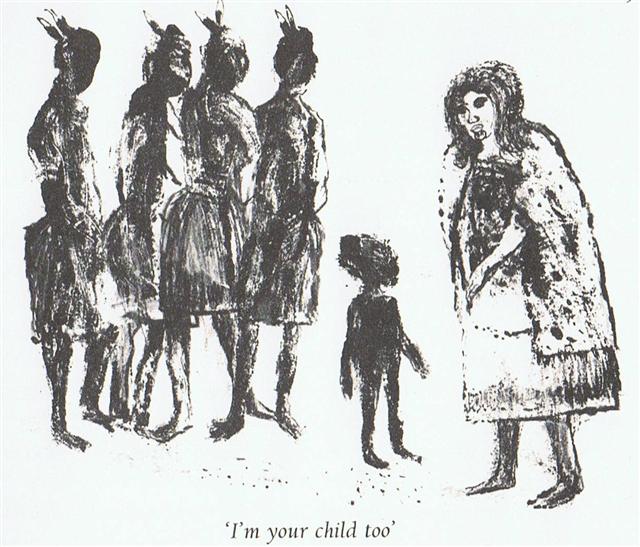
Then he had his given name, Maui tikitiki
a Taranga, and later he acquired other
names for different sides of his character.
According to what he was up to he might be
known as Maui nukarau, or
Maui-the-trickster; Maui atamai,
Maui-the-quick-witted; Maui mohio,
Maui-the-knowing; Maui toa,
Maui-the-brave; and so on.
He was an expert at the game of teka,
or dart-throwing, and all the best patterns
in the string game of whai, or cat's
cradles, were invented by Maui.
He was also a great kite-flier, and the
story is told of a small boy of another name
(but it could only have been Maui) who once
came half out of the water and snatched the
kite-string of a child on the land. He then
slipped back into the sea and continued
flying it from under the water until his
mother was fetched, for she was the only one
who could control him and make him behave at
that time.
It was Maui, moreover, who invented the type
of eel-trap that prevents the eel from
escaping once it is in. After he had slain
Tuna roa he constructed a hinaki
that had a turned-back entrance with spikes
pointing inwards, so that the eels went in
for the bait and were trapped. Thus he
always caught more eels than all his
brothers put together.
Again, it was Maui who first put a barb on
his spear for catching birds. The spears of
his brothers all had smooth points, but Maui
secretly attached a barb to his, and took it
off again so that his brothers would not
know. In the same way also he secretly
barbed his fish-hooks and always caught more
fish than they. This lead to some
unpleasentness between them.
The brothers grew tired of all his tricks,
and tired of seeing him haul up fish by the
kitful when they caught only a few. So they
did their best to leave him behind when they
went out fishing. One day he assumed the
form of a tiwaiwaka, or fantail, the
restless, friendly little bird that flits
round snapping flies. He flew on to their
canoe as they were leaving and perched on
the prow.
But they saw through this at once and turned
back, and refused to go out with Maui on
board. They said they had had enough of his
enchantments and there would only be trouble
if he went with them. This meant that he had
to stay at home with his wives and children,
with nothing to do, and listen to his wives
complaining about the lack of fish to eat.
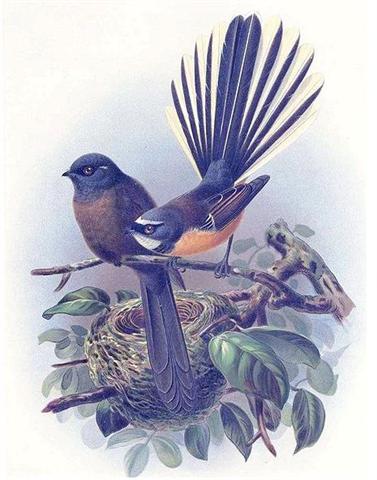
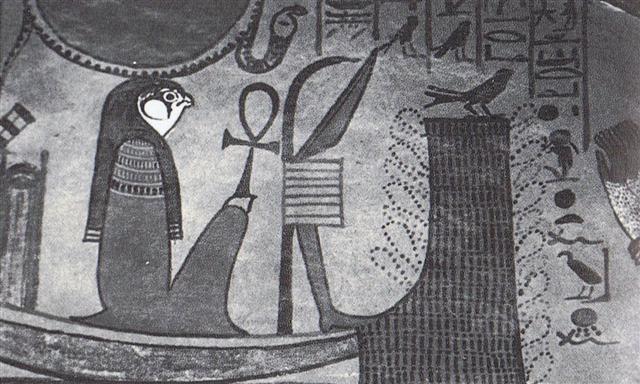
'Oh, stop it, you women', he said one day
when their grumbling had got on his nerves.
'What are you fussing about? Haven't I done
all manner of things by my enchantments? Do
you think a simple thing like catching a few
fish is beyond me? I'll go out
fishing, and I'll catch a fish so big that
you won't be able to eat it all before it
goes bad.'
He felt better when he had said this, and
went off to a place where women were not
allowed, and sat down to make himself a
fish-hook. It was an enchanted one, and was
pointed with a piece chipped off the jawbone
of his great ancestress, Muri ranga
whenua.
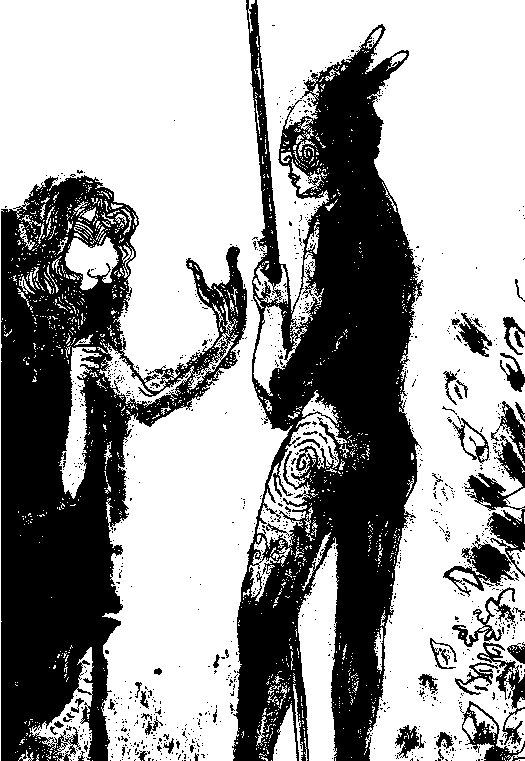
When it was finished he chanted the
appropriate incantations over it, and tucked
it under his maro, the loin cloth
which was all he wore.
Meanwhile, since the weather looked settled,
the brothers of Maui were tightening the
lashings of the top strakes of their canoe,
to be ready for an expedition the following
day. So during the night Maui went down and
hid himself beneath the flooring slats. The
brothers took provisions and made an early
start soon after daybreak, and they had
paddled some distance from the shore before
Maui nukarau crept out of his hiding
place. All four of them felt like turning
back at once, but Maui by his enchantments
made the sea stretch out between their canoe
and the land, and by the time they had
turned the canoe round they saw that they
were much further out than they had thought.
'You might as well let me stay now; I can do
the bailing', said Maui, picking up the
carved wooden bailing scoop that was lying
beside the bailing-place of the canoe. The
brothers exchanged glances and shrugged
their shoulders. There was not much point in
objecting, so they resumed their paddling,
and when they reached the place where they
usually fished, one of them went to put the
stone achor overboard.
'No, no, not yet!' cried Maui. 'Better to go
much further out.' Meekly, his brothers
paddled on again, all the way to their more
distant fishing spot, which they only used
when there was no luck at the other one.
They were tired out with their paddling, and
proposed that they should anchor and put
their lines overboard.
'Oh, the fish here may be good enough for
you,' said Maui, 'but we'd do much better to
go right out, to another place I know. If we
go there, all you have to do is put a line
over and you'll get a bite. We'll only be
there a little while and the canoe will be
full of fish.' Maui's brothers were easy to
persuade, so on they paddled once more,
until the land had sunk from sight behind
them. Then at last Maui allowed them to put
he anchor out and bait their lines.
It was exactly as he had said it would be.
Their lines were hardly over the side before
they all caught fish. Twice only they had
put their lines out when the canoe was
filled with fish. They had so many that it
would have been unsafe to catch more, for
the canoe was now getting low in the water.
So they suggested going back.
'Wait on,' said Maui, 'I haven't tried my
line yet.' 'Where did you get a
hook?' they asked. 'Oh, I have one of my
own', said Maui. So the brothers knew for
certain now that there was going to be
trouble, as they had feared. They told him
to hurry and throw his line over, and one of
them started bailing. Because of the weight
of the fish they were carrying, water was
coming in at the sides. Maui produced his
hook from underneath his
maro,
a magnificent, fishing hook it was, with a
shank made of paua shell that
glistened in the sunlight. Its point was
made of the jawbone of his ancestress, and
it was ornamented at the top of the shank
with hair pulled from the tail of a dog.
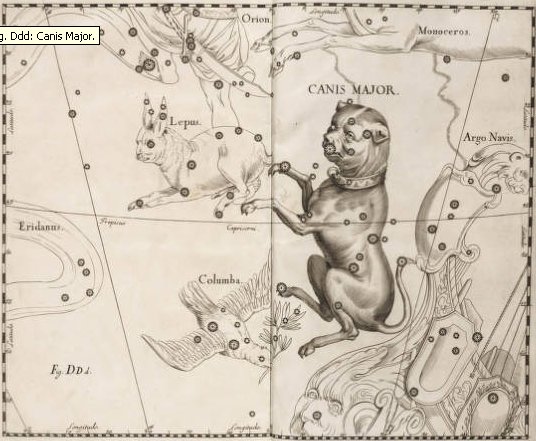
He snooded it to a line that was lying in
the canoe. Boastful Maui behaved as if it
were a very ordinary sort of fish-hook, and
flashed it carelessly. Then he asked his
brothers for some bait. But they were
sulking, and had no wish to help him. They
said he could not have any of their bait. So
Maui atamai doubled his fist and
struck his nose a blow, and smeared the hook
with blood, and threw it overboard.
'Be quiet now,' he told his brothers. 'If
you hear me talking to myself don't say a
word, or you will make my line break.' And
as he paid out the line he intoned this
karakia, that calls on the north-east
and south-east winds:
Blow gently, whakarua, / blow gently,
mawake, / my line let it pull
straight, / my line let it pull strong. / My
line it is pulled, / it has caught, / it has
come. /
The land is gained, / the land is in the
hand, / the land long waited for, / the
boasting of Maui, / his great land / for
which he went to sea, / his boasting, it is
caught.
/
A
spell for the drawing up of the world.
The brothers had no idea what Maui was up to
now, as he paid out his line. Down, down it
sank, and when it was at the bottom Maui
lifted it slightly, and it caught on
something which at once pulled very hard.
Maui pulled also, and hauled in a little of
his line. The canoe heeled over, and was
shipping water fast. 'Let it go!' cried the
frightened brothers, but Maui answered with
the words that are now a proverb: 'What Maui
has got in his hand he cannot throw away.'
'Let go?' he cried. 'What did I come for but
to catch fish?' And he went on hauling in
his line, the canoe kept taking water, and
his brothers kept bailing frantically, but
Maui would not let go.
Now Maui's hook had caught in the
barge-boards of the house of Tonganui, who
lived at the bottom of that part of the sea
and whose name means Great South; for it was
as far to the south that the brothers had
paddled from their home. And Maui knew what
it was that he had caught, and while he
hauled at his line he was chanting the spell
that goes:
O
Tonganui / why do you hold so stubbornly
there below?
/
The power of Muri's jawbone is at work on
you, / you are coming, / you are caught now,
/ you are coming up, / appear, appear.
/
Shake yourself, / grandson of Tangaroa the
little.
The fish came near the surface then, so that
Maui's line was slack for a moment, and he
shouted to it not to get tangled.
But then the fish plunged down again, all
the way to the bottom. And Maui had to
strain, and haul away again. And at the
height of all this excitement his belt
worked loose, and his maro [cfr the
month name Maro for June] fell off
and he had to kick it from his feet.
He had to do
the rest with nothing on.
The brothers of Maui sat trembling in the
middle of the canoe, fearing for their
lives. For now the water was frothing and
heaving, and great hot bubbles were coming
up, and steam, and Maui was chanting the
incantation called Hiki, which makes
heavy weights light.
At length there appeared beside them the
gable and thatched roof of the house of
Tonganui, and not only the house, but a huge
piece of the land attached to it.
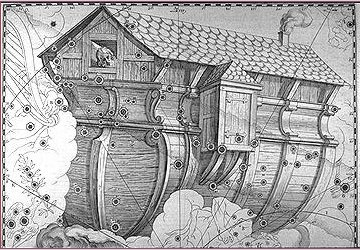
The brothers wailed, and beat their heads,
as they saw that Maui had fished up land,
Te Ika a Maui, the fish of Maui. And
there were houses on it, and fires burning,
and people going about their daily tasks.
Then Maui hitched his line round one of the
paddles laid under a pair of thwarts, and
picked up his maro, and put it on
again. 'Now while I'm away,' he said, 'show
some common sense and don't be impatient.
Don't eat food until I come back, and
whatever you do don't start cutting up the
fish until I have found a priest and made an
offering to the gods, and completed all the
necessary rites. When I get back it will be
all right to cut him up, and we'll share him
out equally then. What we cannot take with
us will keep until we come back for it.'
Maui then returned to their village. But as
soon as his back was turned his brothers did
the very things that he had told them not
to. They began to eat food, which was a
sacrilege because no portion had yet been
offered to the gods. And they started to
scale the fish and cut bits off it. When
they did this, Maui had not yet reached the
sacred place and the presence of the gods.
Had he done so, all the male and female
deities would have been appeased by the
promise of portions of the fish, and
Tangaroa would have been content. As it was
they were angry, and they caused the fish of
Maui to writhe and lash about like any other
fish. That is the reason why this land,
Aotearoa, is now so rough and
mountainous and much of it so unuseful to
man. Had the brothers done as Maui told them
it would have lain smooth and flat, an
example to the world of what good land
should be. But as soon as the sun rose above
the horizon the writhing fish of Maui became
solid underfoot, and could not be smoothed
out again. This act of Maui's, that gave our
people the land on which we live, was an
event next in greatness to the separation of
the Sky and Earth.
Afterwards these young men returned to their
home in
Hawaiki,
the homeland. Their father, Makea tutara,
was waiting for them when they beached their
canoe, singing a chant that praised the
mighty fishing feat of Maui. He was
delighted with Maui, and said to him in
front of the brothers:
'Among all my children only you, Maui
tikitiki, are a great hero. You are the
renewal of the strength that I once had. But
as for your elder brothers here, they will
never be famous like you. Stand up, Maui
tikitiki, and let your brothers look at
you.'
This was all that Makea tutara had to
say to Maui on that occasion. Afterwards
Maui fetched his mother also, and brought
her to Hawaiki, and they all lived
together there. Thus was dry land fished up
by Maui, which had lain beneath the sea ever
since the great rains that were sent by the
Sky father and the god of winds. The Maori
people say that the north island of
Aotearoa, which certainly is shaped much
like a fish, is Te Ika a Maui; and
according to some tribes the south island is
the canoe from which he caught it. And his
hook is the cape at Heretaunga once
known as Te matau a Maui, Maui's
Fishhook (Cape Kidnappers).
In some of the other islands which lie
across the sea towards Hawaiki, the
people say that theirs is the land that Maui
pulled up from below. |
|


































